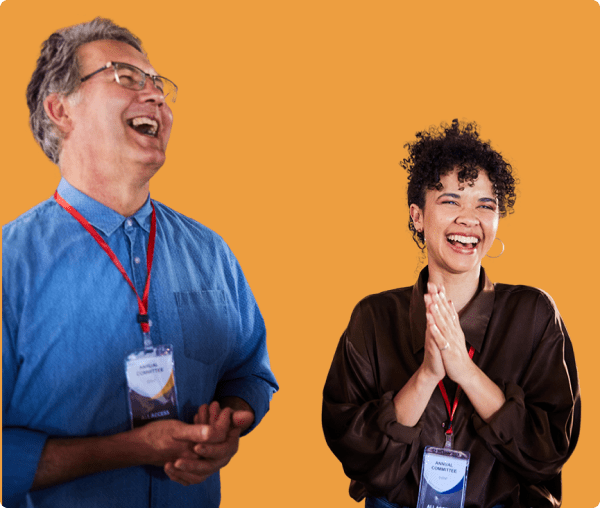From C-suite to deskless: driving employee engagement
 Gohar Chichian
·
6 minute read
Gohar Chichian
·
6 minute read

The benefits of employee engagement

Improving employee engagement can reap many benefits, both for the employee and employer. This includes:
- Professional growth and development of leadership skills
- Networking opportunities that build team communication
- Increased job satisfaction, morale, and engagement
- Enhanced company image and community impact
- Attracting and retaining talent
Employee engagement strategies with CBRE

We recently hosted a discussion with CBRE to discuss their employee engagement activities. With over 130,000 employees operating in over 100 countries, CBRE is a global leader in global real estate and investment services that helps businesses and people thrive. CBRE Cares is their corporate philanthropy and volunteer program, and has been around for about 20 years.
We were joined by Veronica Hayden, Global Director of CBRE Cares and Ryan N. Mitchell, Director of DE&I at CBRE Advisory Services. The conversation was led by Mila Singh, VP of People and Culture at Catchafire. Read the highlights below or watch the full recording here.
What is your personal motivation for staying in this work?
Ryan: For me, it stems back to my values and being a really strong values-oriented person. I was always taught to put other people first, to serve the community that’s around me, to hear from other people and amplify voices that might otherwise be smothered. It’s important for me as a diversity, equity, and inclusion professional to be able to bring together my philanthropic background and community justice focus to make sure that we are driving significant impact.
Veronica: It can be so easy to get bogged down in that every day of the job and the minutiae. I have to just take a step back and remember that all the things I’m doing–the big, the small, the frustrating–are contributing to making an impact in the communities we serve and are helping to increase employee engagement. We know from several studies that employee engagement can lead to positive business outcomes.
I love to see employees posting on our internal and external social media about their volunteering or fundraising event, and expressing pride at working for a company that supports their charitable endeavors. We’ve recently started focusing on ways to get employees to post internally, and it’s been really successful for us.
Where are you in your company on designing corporate giving strategies to drive employee engagement?
Veronica: This program’s in its early stages in a lot of ways and had low visibility when we first started. We’re currently keeping existing programs running while focusing on raising new awareness, making improvements to what already exists, and launching new initiatives and processes. We’re also educating ourselves on the cultural differences in other countries and determining how we can best scale the programs.
We have made tremendous progress in the last three years that I’m really proud of, but we still have such a long way to go with such a big employee base and making sure they’re all aware of the programs and participating.
I want to ask about your role as the DEI leader, which in some places, sadly, has become an endangered species. We hear stories about these roles getting cut, dimmed down, and deprioritized. How are you personally navigating that and how are you keeping your role thriving at CBRE by ensuring that you’re getting buy-in and engagement from your senior leaders?
Ryan: We have to be really mindful that the world is a huge place. Because CBRE is operating in so many different markets, there’s so many different perspectives. When I’m talking to leaders in 25 countries that we are focusing on in the advisory services business, it really is about what is inclusive. What are the strategies that we can support that help move you forward in your area? We are localizing our global strategy, centering it around internal culture, bringing in and promoting great talent, and then impacting communities. There’s a unique perspective that each country lead and partner has, and that helps us to drive inclusive behaviors throughout the organization.
In the United States, there’s still so much work we can be doing, especially around communities that we serve…I think there’s so much work that we can do as a professional services organization that serves so many different types of clients across the spectrum of industry. It’s easy to keep my head up around this space, just because there’s so much work to do, so many more lessons for me to learn, and so many more people for me to meet and engage with.
We know many struggle with gaining traction on strategy, especially with deskless employees and dual-location employees. What have been some strategies launched by CBRE Cares?
Veronica: For us, it’s not just the deskless employees that’s been difficult to communicate to or get engaged. Our employees that work at client sites and primarily use client email addresses, they have a CBRE email but they maybe don’t check that as much since it’s not what they do every day. Those employees account for more than 50% of our workforce.
"The biggest traction we’ve seen is getting to the managers. Information coming from them, someone they know, sees a better response, instead of a corporate email coming from me or my boss. Providing templates to the managers that they can send out has been really helpful."
Veronica Hayden, Global Director
CBRE Cares
When I first started at CBRE, we were at less than 1% participation. Although several factors go into that, simple awareness seemed to be one of the largest contributing factors. So I created a presentation about CBRE Cares for employees to use…Almost every call, I had at least one employee who would share their surprise about not knowing that they had volunteer time off or matching donations. In that first year, we went from .1% to over 3% participation.
We’re also working with our HR team to incorporate information about CBRE Cares into the new hire onboarding, and creating more resources for managers. Introducing virtual volunteering has also been successful in reaching more employees, particularly those who are remote or hybrid.
Ryan, on your end, what have been some proven strategies to engage the C-suite and senior leaders in volunteering, giving back, and engaging with DEI?
Ryan: When we think about our commitment to DEI and philanthropy, it really does start at the top. It always helps when you have a leader who actually is committed. Bob Sulentic, our CEO, is committed to philanthropy, DEI, and drives those initiatives within the whole C-Suite. When communicating with those leaders, it’s important to have data-driven, evidence-based communication so they can understand how this helps drive results.
"There’s a correlation between employee engagement and philanthropy. People are more engaged when they’re doing philanthropic work together. It helps to build teams. Talk to them not just about studies, but real-life qualitative studies, like our employee engagement survey."
Ryan N. Mitchell, Director of DE&I
CBRE Advisory Services
Are you seeing results that prove a culture of giving is good for business?
Ryan: Yes, absolutely. We have DEI councils throughout the organizations and they're market-driven. Right now, they’re putting forth our rise to inclusion training and they’re advertising locally. We made it a competition to see who’s going to complete this training by percentage - will it be Chicago, New York, San Francisco? We find when we bring those groups together, the leaders talk about the work they’re doing to drive inclusion, as well as volunteer and philanthropic efforts. I encourage them to log those hours in our CBRE Cares…so it becomes an ecosystem.
We’ve seen storytelling is really important both for companies as well as the nonprofits that are being supported. How do you get those stories from staff and capture the moments happening behind the scenes?
Veronica: We have a big button that says ‘want to tell your story? Click here.’ And there’s a form that they can fill out and upload pictures. People like to be recognized and featured in things, so we’ll put that in newsletters and our internal social platform.
What are the impact metrics that you care about in your seat? What are you looking to track and share out?
Veronica: Right now, what we’re tracking is the participation rate, the number of volunteer hours. When we were doing the 2021 reporting, we had 4,500 volunteer hours put into our online platform. I knew there was more, but that’s what we had to report.
"Through the awareness campaign and creating more volunteer opportunities, the very next year that went from 4,500 to over 40,000 volunteer hours, and this year, it’s over 60,000 hours logged. We know they’re getting more engaged, logging their hours, learning how to use the portal, and hearing our message."
Veronica Hayden, Global Director
CBRE Cares
What kind of leadership roles do employee resource groups create and foster for employee engagement, and ultimately the kind of results that support good business outcomes?
Ryan: There are over 25,000 employees across the globe who participate in our employee business resource groups and they are volunteer-driven. They help to put on events locally and globally, and help to drive impact. They’re even able to provide some business solutions for our business and clients. We’re so proud of the 25,000 employees who are participating right now and want to see that membership continue to grow.
Veronica: We’re really focusing on our relationships and work really closely with the EBRG managers. This is kind of low hanging fruit, right? We know these employees are engaged so how they get them to put out our message of what we’re doing and how we can help them create a volunteer activity, in-person or virtual, that they can activate and do with that team and get them engaged in that way.
Mila: I think we learned a lot of really amazing takeaways. Everything from localizing strategy, getting buy-in from managers, overview presentations, recognition, programming, the data, the power of stories, and what you’re doing to collect data around that.
Watch the rest of the recording here.
Catchafire’s employee engagement software
Are you seeking new strategies on how to improve employee engagement? Catchafire can help. With a close correlation between employee engagement and retention, implementing employee volunteer programs can create a more motivated and engaged workforce.Discover how Catchafire can transform your approach to employee engagement and request a demo today.



